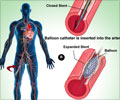Bivalirudin minimized the risk of bleeding and stent thrombosis and increased the likelihood of surviving a heart attack.
- Heparin is the most used anticoagulant during the treatment of primary percutaneous coronary intervention
- Anticoagulant bivalirudin has been observed to dramatically lower thrombosis, severe bleeding, and death in heart attack patients as compared to heparin
“For the first time, this study identifies the best and safest treatment course for patients undergoing stenting to treat a STEMI heart attack,” says co-Principal Investigator Gregg W. Stone, MD, Director of Academic Affairs for the Mount Sinai Health System and Professor of Medicine (Cardiology), and Population Health Science and Policy, at Icahn Mount Sinai. “Compared with heparin, bivalirudin plus a short infusion substantially improved the likelihood of surviving a STEMI and reduced the two most feared complications- major bleeding and stent thrombosis.”
Patients who had STEMI heart attacks had ‘primary PCI’ in the ‘BRIGHT-4’ experiment, an urgent stenting treatment to maintain heart muscle function. Anticoagulant medication is necessary for patients undergoing this minimally invasive operation to successfully unblock the blocked heart artery and stop blood clots from developing in the future and leading to another heart attack.
Treatment of Heart Attack
Heparin is the anticoagulant that is most frequently administered during primary PCI. However, because of how unpredictable its effects can be, there may be more bleeding and blood clots than is ideal. A relatively recent anticoagulant with more predictable “blood thinning” effects is bivalirudin. For patients with STEMI, heparin and bivalirudin have been compared in six previous large, randomized trials, but their administration methods and supporting medicines varied in those studies.A group of researchers led by Dr Stone and Yaling Han, M.D., PhD, of Shenyang Northern Hospital in Shenyang, China, examined 6,106 patients who had participated in the trial at 87 locations around China between February 2019 and April 2022. All underwent primary PCI for STEMI therapy, almost all with a technique that focused on the blocked heart artery using the radial artery in the wrist. Heparin and bivalirudin, the two most popular regimens demonstrated in earlier studies to be the safest and most efficient, were given to patients in random order. Heparin was given intravenously to one group only. The second group received high-dose IV infusions of bivalirudin for two to four hours following the procedure, followed by an IV infusion of bivalirudin through an IV.
Risk of Anticoagulant Therapies in Heart Attack
Following the procedure, the patients were observed by the researchers for 30 days. During this time, STEMI patients are most at risk for adverse events. The study’s main objective was to compare the frequency of serious bleeding or all-cause mortality. In comparison to those treated with bivalirudin, 4.4% of those treated with heparin died or experienced a significant bleed within 30 days, according to research. Overall, comparing patients in the bivalirudin group to those using heparin, there was a statistically significant reduction in serious bleeding or mortality of 31%.The precise incidence of death alone and significant bleeding alone between the groups were then specifically examined by the researchers. They discovered that the mortality rate fell from 3.9% in patients receiving heparin to 3% in those receiving bivalirudin. Additionally, bivalirudin reduced severe bleeding from 0.8% in the heparin group to 0.2%. These two differences both had statistical significance.
“These results are dramatic,” Dr Stone said. “The simple decision to use bivalirudin during primary PCI in patients with heart attacks, which is now generic and thus inexpensive, can save hundreds of thousands of lives per year and prevent major bleeding and stent thrombosis compared with heparin.”
Source-Medindia
















